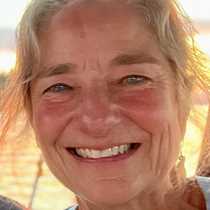Tracy Arm and Endicott Arm, Southeast Alaska
The Power of Ice
Glaciers carve U-shaped valleys and round rock mountains, and they grind gravel to fine rock flour. They calve icebergs with tremendous force – enough to swamp small boats and wash tender humans into dangerously cold water. But icebergs sometimes nurture life. For harbor seals, icebergs serve as birthing platforms where mothers nurse and sleep alongside their tiny new pups.
By breakfast we were near the end of Tracy Arm, a spectacular fjord that cuts a path inland nearly 30 miles. The ship went as far as Marguerite Island, at the fork between Sawyer and South Sawyer glaciers. The glaciers have been very active, and the ship moved slowly as ice chunks tapped against the hull. Two wilderness rangers who were camping on the island joined us aboard the Sea Lion. Their unusual jobs combine education with monitoring of seal populations and remote wilderness campsites. They left us when we reached Harbor Island, paddling off into the drizzle in their kayaks.
On our way out of Tracy Arm, the ship nosed right up to Hole in the Wall waterfall. We were so close to the tumbling water that people on deck got misted, and there were questions about small flowers on shore. As the ship turned left into Endicott Arm, Steve gave a presentation on Alaskan forests.
At Dawes Glacier we boarded Zodiacs and motored along smooth rock faces, up to waterfalls, and we slowly and quietly approached harbor seals and pups on icebergs. (It is nearly the peak of pupping season.) Arctic terns flew overhead, and a few of us had an extremely rare sighting of a wolverine. Zodiacs motored towards the glacier, but stopped a safe distance off. Large chunks of ice occasionally tumbled off the face of the glacier. After the largest bergs calved, we heard ‘white thunder,’ and minutes later the Zodiacs were gently lifted on swells.
As we watched the glacier and hoped to see calving, two people aboard an aluminum skiff motored towards it. With the spectacular backdrop, their small boat was barely visible to us. Minutes later, the largest icebergs fell from the face of the glacier.
When we were all back aboard Sea Lion, several people reported seeing a red flare on shore, right by the glacier. Crew members immediately left by Zodiac to investigate. The two people from the skiff had stepped ashore just before the largest iceberg fell. Waves from the calving swept them into the 41 F degree water and swamped their skiff. After five minutes in the water, they were soaked and extremely chilled. They were brought on board Sea Lion, given food, warm showers, and dry clothes from the ship’s gift shop. We returned them to their anchored fishing boat, which was about six miles down Endicott Arm. We (and they, too) were very, very grateful we had been there to assist.
The Power of Ice
Glaciers carve U-shaped valleys and round rock mountains, and they grind gravel to fine rock flour. They calve icebergs with tremendous force – enough to swamp small boats and wash tender humans into dangerously cold water. But icebergs sometimes nurture life. For harbor seals, icebergs serve as birthing platforms where mothers nurse and sleep alongside their tiny new pups.
By breakfast we were near the end of Tracy Arm, a spectacular fjord that cuts a path inland nearly 30 miles. The ship went as far as Marguerite Island, at the fork between Sawyer and South Sawyer glaciers. The glaciers have been very active, and the ship moved slowly as ice chunks tapped against the hull. Two wilderness rangers who were camping on the island joined us aboard the Sea Lion. Their unusual jobs combine education with monitoring of seal populations and remote wilderness campsites. They left us when we reached Harbor Island, paddling off into the drizzle in their kayaks.
On our way out of Tracy Arm, the ship nosed right up to Hole in the Wall waterfall. We were so close to the tumbling water that people on deck got misted, and there were questions about small flowers on shore. As the ship turned left into Endicott Arm, Steve gave a presentation on Alaskan forests.
At Dawes Glacier we boarded Zodiacs and motored along smooth rock faces, up to waterfalls, and we slowly and quietly approached harbor seals and pups on icebergs. (It is nearly the peak of pupping season.) Arctic terns flew overhead, and a few of us had an extremely rare sighting of a wolverine. Zodiacs motored towards the glacier, but stopped a safe distance off. Large chunks of ice occasionally tumbled off the face of the glacier. After the largest bergs calved, we heard ‘white thunder,’ and minutes later the Zodiacs were gently lifted on swells.
As we watched the glacier and hoped to see calving, two people aboard an aluminum skiff motored towards it. With the spectacular backdrop, their small boat was barely visible to us. Minutes later, the largest icebergs fell from the face of the glacier.
When we were all back aboard Sea Lion, several people reported seeing a red flare on shore, right by the glacier. Crew members immediately left by Zodiac to investigate. The two people from the skiff had stepped ashore just before the largest iceberg fell. Waves from the calving swept them into the 41 F degree water and swamped their skiff. After five minutes in the water, they were soaked and extremely chilled. They were brought on board Sea Lion, given food, warm showers, and dry clothes from the ship’s gift shop. We returned them to their anchored fishing boat, which was about six miles down Endicott Arm. We (and they, too) were very, very grateful we had been there to assist.




